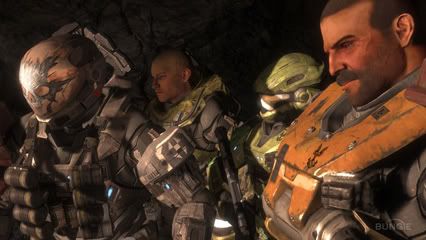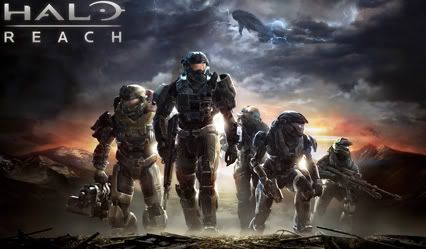- Format: 360
- Unleashed: Out Now
- Publisher: Microsoft Game Studios
- Developer: Bungie
- Players: 1-4 in Co-op/Firefight, 2-16 Online multiplayer
- Site: bungie.net
Starting up Halo: Reach, it’s easy to get lost in its sea of features. From a substantial campaign mode with online co-op, to Firefight mode, competitive multiplayer, and a robust suite of tools for creating your own maps and gametypes, Bungie’s final Halo game is absolutely brimming with content. That it’s all incredibly polished and worthwhile makes it one of this year’s must-play games.
It starts with campaign mode. From the beginning it’s clear that Bungie put a lot of thought into what was good and bad about each entry of the series. The very sci-fi goofiness of the Covenant backstory is toned down in favour of a simpler tale of humanity versus an alien threat. The focus is similar to Halo 3: ODST in its themes of comradery and heroism, but on an epic scale more fitting of the series’ pedigree.
Halo: Reach tells the story of Noble Team, a squad of six Spartan super-soldiers (because six Master Chiefs are better than one), and the role they play during the fall of the planet Reach. Thanks to some serious improvements to human face animation and some extra effort to give the team some personality, Reach’s story is more heartfelt, its stakes are higher, and the threat of destruction is more real than ever.
 Possibly the smartest change is the overhaul of the Covenant. The smorgasbord of alien races you fight stray from the previous games’ rainbow-colored cartoon character vibe. They no longer speak human languages, and their pink and purple neon flourishes are more subdued, more foreign and frightening than giggle-worthy.
Possibly the smartest change is the overhaul of the Covenant. The smorgasbord of alien races you fight stray from the previous games’ rainbow-colored cartoon character vibe. They no longer speak human languages, and their pink and purple neon flourishes are more subdued, more foreign and frightening than giggle-worthy.
They’re also smarter. If you’re a long-term fan of the series, you may have been a bit disappointed in the evolution of the enemy AI. Bungie apparently was too, bringing back Elites (Halo’s most cunning enemy) and making all of the alien races more active and mobile than ever.
Reach’s campaign offers more gameplay divergences than any entry to date. From space combat to jetpack platforming and the occasional deliberate downtime, there’s a ton of variety, and it’s almost all expertly paced. Only one moment (a turret sequence in the final level) hurts more than it helps, briefly deflating the excitement in what is otherwise a perfect and immediately replayable campaign.
 Almost all of this replayability carries over to the game’s firefight mode, which places you in encounters against wave after wave of increasingly powerful Covenant. The mode is vastly improved from its original appearance in ODST, offering a ton of customisation options, a matchmaking mode for playing with strangers when there’s no friends around, and a great selection of maps to fight on. It’d be easy to get lost in Firefight for weeks without ever touching all of Reach’s other content.
Almost all of this replayability carries over to the game’s firefight mode, which places you in encounters against wave after wave of increasingly powerful Covenant. The mode is vastly improved from its original appearance in ODST, offering a ton of customisation options, a matchmaking mode for playing with strangers when there’s no friends around, and a great selection of maps to fight on. It’d be easy to get lost in Firefight for weeks without ever touching all of Reach’s other content.
But of course you’re not going to do that, because Halo: Reach once again takes the crown as the definitive online multiplayer game on consoles. Reach has so much variety and depth in its combat that it’s hard to compare it to the competition. Simply put, things happen in Halo that don’t happen in other games, and they happen constantly.
Aiding in the endless Kodak moments are a collection of armour abilities that can be selected from whenever you die. Ranging from jet packs to bubble shields and hologram decoys, these toys may seem like gimmicks, but they add more to Halo than any of the series’ previous additions. Halo 2’s dual-wielding and Halo 3’s equipment pick-ups are gone because they were clumsy and ultimately messed with the formula. But armour abilities have quickly become an integral part of the experience. They’re the fourth tool at your disposal, alongside guns, grenades, and melee attacks, and they’re every bit as critical to your success.
 Beyond that, everything is pretty much refinement. Reach offers an epic crap-ton of game modes, all of which are deeply customisable. Then there’s the way you connect with your friends and find matches, which is still years beyond what every other multiplayer game on the market has to offer.
Beyond that, everything is pretty much refinement. Reach offers an epic crap-ton of game modes, all of which are deeply customisable. Then there’s the way you connect with your friends and find matches, which is still years beyond what every other multiplayer game on the market has to offer.
If there’s anything to fault it for, it’s the occasionally sloppy game mode and the light selection of unique multiplayer maps. The first is almost a non-issue, as Bungie constantly updates their game rules for optimal balance, but the second issue is a bit more suspect. It’s especially apparent in the Invasion gametype, which places Spartans against Elites in a multi-tiered, objective-based match in only one of two maps.
The remedy, it seems, is the game’s new take on Forge. What started as a light editor for object placement in existing Halo 3 maps has blossomed into a full-fledged level editor in Reach. Diving into the robust and enormous Forge World environment allows players to go nuts in a sandbox bigger than any environment you’ve ever seen in a Halo game. The result: the game comes packed with remakes of classic Halo 1 and 2 maps, and players have already begun the process of remaking even more originals.
We could keep going all day with one great feature after another, but the point is pretty clear. Reach is the most fully-featured, uniformly excellent Halo game, and one of the best first-person shooters to come along in years. Few games have ever so fully justified their price of admission. At once a re-imagining of the series and a culmination of nine years of lessons, Halo: Reach is Bungie’s best and most mature game to date.
 10/10
10/10
















Comments